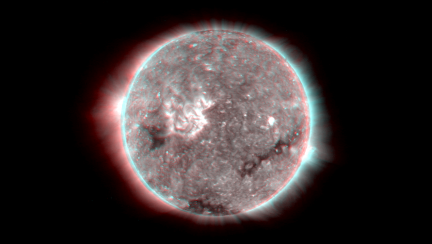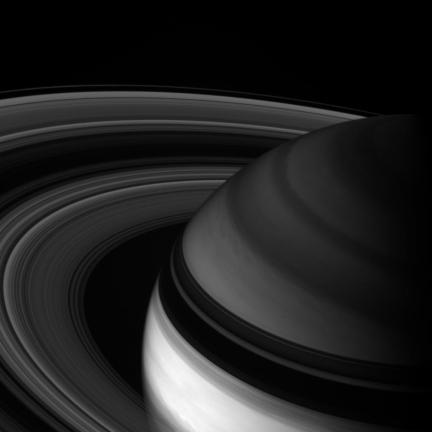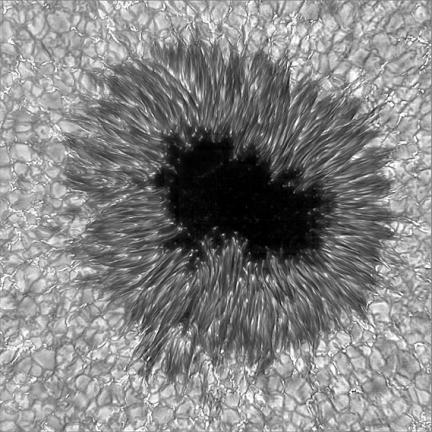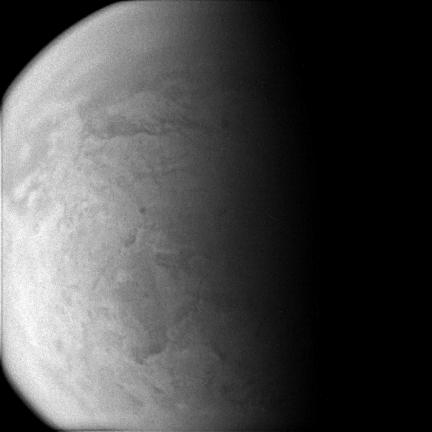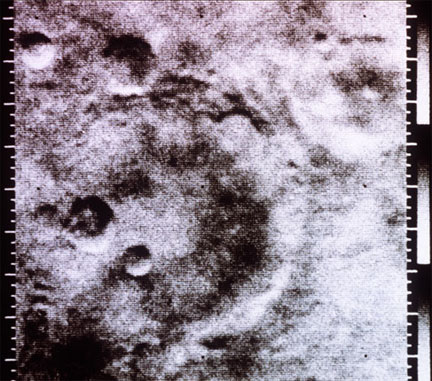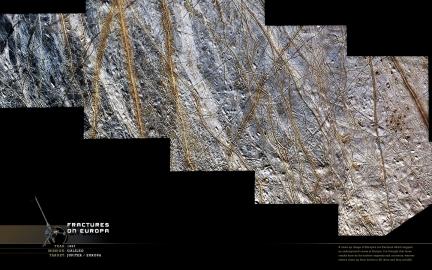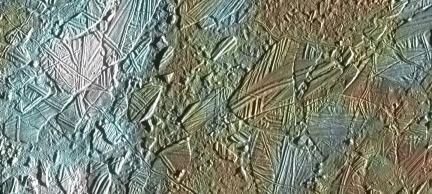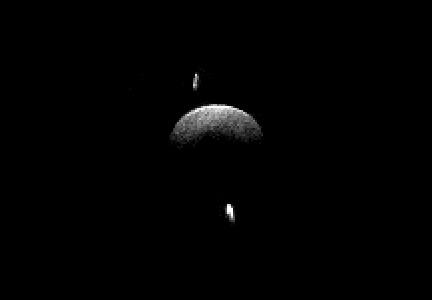 Just in time for Valentine’s Day… a ménage à tous! Aricebo captured this radar image of asteroid 2001SN263 which turned out to be a triple asteroid. This is the first near-Earth object found to have more than one moonlet. Is it just me or does that main asteroid seem orb-like?
Just in time for Valentine’s Day… a ménage à tous! Aricebo captured this radar image of asteroid 2001SN263 which turned out to be a triple asteroid. This is the first near-Earth object found to have more than one moonlet. Is it just me or does that main asteroid seem orb-like?
New Horizons Opens its Vault
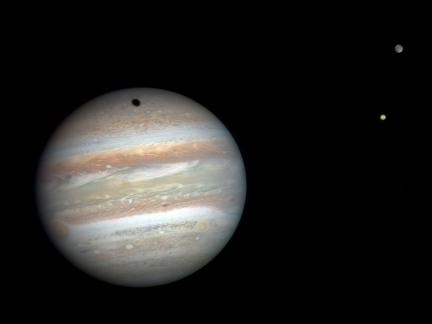 The New Horizons team has made all the MVIC (Multispectral Visible Imaging Camera) images as well as the LORRI (Long Range Reconnaissance Imager) images from the Jupiter encounter available for imagers to kick around. The above image is by Gordan Ugarkovic and is apparently a “colorized” version of a monochrome he created using earth based observations of the planet from around the same time. In addition to the two moons (and a shadow), also visible are both the Great Red Spot as well as the “Red Junior” spot which has in recent months has become a new notable feature of Jupiter.
The New Horizons team has made all the MVIC (Multispectral Visible Imaging Camera) images as well as the LORRI (Long Range Reconnaissance Imager) images from the Jupiter encounter available for imagers to kick around. The above image is by Gordan Ugarkovic and is apparently a “colorized” version of a monochrome he created using earth based observations of the planet from around the same time. In addition to the two moons (and a shadow), also visible are both the Great Red Spot as well as the “Red Junior” spot which has in recent months has become a new notable feature of Jupiter.
3-D Sun
Mystery man “hortonheardawho” posted this to his flickr account in April of 07. If you have a pair of 3-D glasses on you (check your purse), then you can gaze at the sun in 3 dimensions and not burn out your retinas. The images were taken by NASA’s STEREO mission to observe the Sun.
Saturnati V
Sharpest Image of The Sun as of 2005
Sharpest Image of The Sun as of 2002
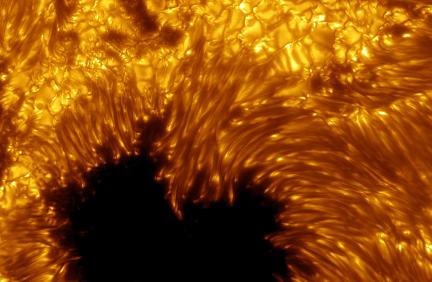 I have to admit this is my first direct lift right from Astronomy Picture of the Day (dating back to November 2002). Some recent images of Solar prominences and arcs are pretty close in quality if not surpass this, but I don’t think I have seen anything comparitively detailed of the actual surface like this. The image was acquired through the ground-based Swedish Solar Telescope located on the Canary Island of La Palma. Despite the ground-based operation, it still was able to make an image of the Sun that surpassed any of those taken by the observatories in orbit at that point in time.
I have to admit this is my first direct lift right from Astronomy Picture of the Day (dating back to November 2002). Some recent images of Solar prominences and arcs are pretty close in quality if not surpass this, but I don’t think I have seen anything comparitively detailed of the actual surface like this. The image was acquired through the ground-based Swedish Solar Telescope located on the Canary Island of La Palma. Despite the ground-based operation, it still was able to make an image of the Sun that surpassed any of those taken by the observatories in orbit at that point in time.
What is seen in the above image is a dark region known as a sunspot which is a planet sized area of unknown origin. 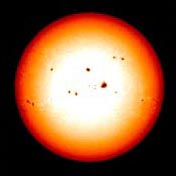 It has a much lower temperature than its surrounding areas and emits a tremendous amount of magnetic activity. Of course, any imaging the Sun in normal visible light with no photographic trickery would result in an entirely white image with no details at all. So the funny thing about these “dark spots” (see visible/white light image at left) is that they are actually blindingly bright to a human eye. It is only when we image these areas in comparitive contrast with the surrounding hotter areas do they appear as dark in photographs. These mysterious spots seem to also appear in abundance in 11 year cycles which also eludes any scientific explanation.
It has a much lower temperature than its surrounding areas and emits a tremendous amount of magnetic activity. Of course, any imaging the Sun in normal visible light with no photographic trickery would result in an entirely white image with no details at all. So the funny thing about these “dark spots” (see visible/white light image at left) is that they are actually blindingly bright to a human eye. It is only when we image these areas in comparitive contrast with the surrounding hotter areas do they appear as dark in photographs. These mysterious spots seem to also appear in abundance in 11 year cycles which also eludes any scientific explanation.
Saturnati IV
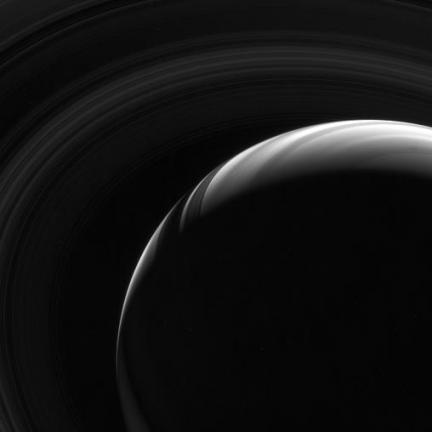 From the Cassini website, “Like black and white photos of earthly family and friends, monochrome images of Saturn can also capture their subject with crisp poignancy. This infrared view from high above Saturn's ringplane highlights the contrast in the cloud bands, the dimly glowing rings and their shadows on the gas giant planet. The overall effect is stirring”.
From the Cassini website, “Like black and white photos of earthly family and friends, monochrome images of Saturn can also capture their subject with crisp poignancy. This infrared view from high above Saturn's ringplane highlights the contrast in the cloud bands, the dimly glowing rings and their shadows on the gas giant planet. The overall effect is stirring”.
Lots of Water on Mars
The top image shows the radar imaging of underground structures on Mars, below that is the typography of that same region and the radar swath is represented by the white line that cuts through it.
In the radar image, the point at which the traces or “layers” split into two (on the left side) is where it is thought that the materials change and so the radar is echoing again off that lower subsurface. They also add that “the strength of the lower echo suggests that the intervening material is nearly pure water ice”, which apparently may translate into a depth of 3.5 kilometres of ice. This image is not alone, additional radar scans have suggested ice that runs to a depth of 1.5km in other places with surely many more to come.
It would seem that the intended purpose of finding where, or if, water exists on Mars has more or less been satisfied. I don’t think that anyone expected to find this much evidence of water on Mars between the recently discovered water flows and now a nearly planetwide (theoretical) underground reservior of pure water ice. Future astronauts on Mars will not go thirsty!
Titan Looking Earthly
Using an infrared camera, we see what Titan might look like if the atmosphere was at least partially clear. This is one of the more Earthly global images I have ever seen of Saturn’s biggest moon. Seeing as how this site’s focus on images is usually true-color and visible light, I rarely post anything on Titan’s surface which requires other means of seeing like radar or using alternate parts of the Electromagnetic Spectrum. This is unfortunate as Titan’s surface is one of the more fascinating places to consider when looking at our “local” cosmic neighborhood.
Life in the Hood: Europa
There are two schools of thought in the world on extra-terrestrial life coming from people who think seriously of such things. One is that the universe is teeming with life, yes… teeming. A good majority of folks these days think the universe is lousy with life forms. The second theory is that here on Earth life is a rare and possibly singular event. Either of these conclusions are quite a leap of faith for lack not only of evidence, but for opportunities to even discover any of the evidence needed to support either assertion. You see, the universe is spread out in a big way. It takes light from Earth a bit over 4 years to reach the nearest star to our sun Alpha Centauri, meaning that any astronomers at Centauri who might be peering out in our general direction see us as we were 4 years ago. So if it takes light that long to get to our nearest neighbor, you can imagine how long it would take our fastest, newest spacecraft to reach there. Using technologies not even mature enough to consider actually using, it still could take us 40+ years just to reach that nearest star… and that’s probably a liberal estimate. So apart from someone developing a hyper-warp drive which can surpass the speed of light (which they tell me is not only impossible but pose an awful lot of other difficult circumstances) or someone at SETI (Search for Extra Terrestrial Intelligence) picks up a faint and 25 year old signal coming from Vega (see the film Contact for reference), it would seem for the time being we are stuck having to search our own neighborhood.
About 30 years ago the outlook for life in our own solar system seemed bleak. The moon was as desolate as one could imagine and Mars when spied by Mariner 4 for the first time, up-close (see above), shocked and disappointed many with a surface that seemed more akin to our moon than with Earth. Gone were all the dreams of Martians directing canals to their great cities or even the hope of a Mars rat scurrying across the red dunes. In addition to this, the assumption was that the rest of the Solar System was hopelessly cold and unworthy of hosting even the smallest of microbes. The gas giants were surface-less hostile environs, most bodies lacked breathable air of any kind and Venus was so hot it would immediately fry anything hoping to eek out a living on its surface. Finally, after the Viking landers determined Mars to be lifeless in the 70’s (in what many now call a flawed experiment) most gave up hope and began seeing the Solar System as nothing more than a place filled with mostly cold lonely destinations offering mankind little more than an ultimate challenge of survival away from home. That was until Voyager sped by Jupiter and its moons a few years later and a small world most have never even heard of, named Europa, held out a glimmer of hope to those in the know.
After returning the first images of Europa’s surface riddled with ridges, cracks and what looked like considerable geological activity (see above wallpaper, actually taken by the Galileo not Voyager) many began to speculate these features must be the result of a vast underground ocean which causes stress on the outer “shell” and causes it to crack. This theory was propped up further when Galileo arrived at Jupiter in the 90’s. Much better resolution images revealed much greater detail including what appeared to be “icebergs” in a large region that from a distance appeared to look like shattered glass. You could easily see where one “berg” broke off from another and floated a distance away by some means (see below). This makes many as sure of the underground ocean on Europa as you can get without actually drilling down through the icy crust and plunking down into the wet core.
So if we have a moon made largely of water ice, who is being internally heated by tidal forces coming from Jupiter, we can almost assume that much of this body would be melted ice as you move down from the rock-hard frozen surface toward the warm center… and… one can assume that somewhere in between hot in the middle and cold on the surface, there may be a large zone of warm waters as cool and warm as that found on any Hawaiian beach. Meanwhile here on Earth, we have found that life survives nearly any hostile environment from 200 degree heat vents of acid water on the ocean floor to microbes found frozen in Antarctica. The theory goes, if life survives in hell on Earth why not a comparable heaven on Europa?
Wallpaper: Enceladus Portrait
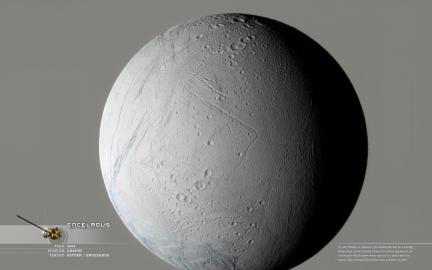 During my run through posting images of the major moons of the solar system, I felt compelled to include this tiny 600km moon in the mix as it has suprised most scientists to be quite an active little place. Usually any body as small as Enceladus would fail to have any geological activity, but in 2006 the Cassini spacecraft discovered that there are several active geysers spewing water and ice into the space around it. These geysers have even established a tenuous atmosphere of mostly water vapor at the southern poles where the geysers are located.
During my run through posting images of the major moons of the solar system, I felt compelled to include this tiny 600km moon in the mix as it has suprised most scientists to be quite an active little place. Usually any body as small as Enceladus would fail to have any geological activity, but in 2006 the Cassini spacecraft discovered that there are several active geysers spewing water and ice into the space around it. These geysers have even established a tenuous atmosphere of mostly water vapor at the southern poles where the geysers are located.
WALLPAPER NOTE: I have to be honest… those stripes in the southern region with the geysers… they aren’t really blue. They would be bright gray like all the rest. Its just irresistable to use the blueish tones because they outline where all this geological activity is going on. I usually don’t use false-color.
